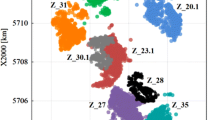Abstract
This paper presents a statistical approach named multivariate hidden Markov modeling (MHMM) and employs it to study the spatial and temporal distribution of earthquakes in the 1985 Yellowstone earthquake swarm. It also explores the potential of the approach for identifying fluid signals in the swarm. As far as the spatial distribution component is concerned, the MHMM detected an upward migration of earthquakes at the beginning of the swarm. This is an important feature of fluid-triggered earthquakes. In terms of the temporal distribution component, the agreement between the MHMM and ETAS modeling results suggests the presence of fluid signals in mid-November of 1985.
Similar content being viewed by others
References
Aitkin M (1997) Contribution to the discussion of paper by S Richardson and PJ Green. J R Stat Soc B 59:766
Altman RM (2004) Assessing the goodness-of-fit of hidden Markov models. Biometrics 60:444–450
Baum LE, Petrie T, Soules G, Weiss N (1970) A maximization technique occurring in the statistical analysis of probabilistic functions of Markov chains. Ann Math Stat 41(1):164–171
Ebel JE, Chambers DW, Kafka AL, Baglivo JA (2007) Non-Poisson earthquake clustering and the hidden Markov model as bases for earthquake forecasting in California. Seismol Res Lett 78:57–65
Granat RA, Donnellan A (2002) A hidden Markov model based tool for geophysical data exploration. Pure Appl Geophys 159:2271–2283
Hainzl S, Fischer T (2002) Indications for a successively triggered rupture growth underlying the 2000 earthquake swarm in Vogtland/NW Bohemia. J Geophys Res 107:2338
Hainzl S, Ogata Y (2005) Detecting fluid signals in seismicity data through statistical earthquake modeling. J Geophys Res 110:B05S07
Hensch M, Riedel C, Reinhardt J, Dahm T, the NICE-People (2008) Hypocenter migration of fluid-induced earthquake swarms in the Tjornes Fracture Zone (North Iceland). Tectonophysics 447:80–94
Husen S, Smith RB, Waite GP (2004) Evidence for gas and magmatic sources beneath the Yellowstone volcanic field from seismic tomographic imaging. J Volcanol Geotherm Res 131:397–410
Kraft T, Wassermann J, Schmedes E, Igel H (2006) Meteorological triggering of earthquake swarms at Mt. Hochstaufen, SE Germany. Tectonophysics 424:245–258
Ma ST, Eaton DW (2009) Anatomy of a small earthquake swarm in southern Ontario, Canada. Seismol Res Lett 80:214–223
McLachlan G, Peel D (2000) Finite mixture models. Wiley series in probability and statistics. Wiley, New York
Ogata Y (1988) Space-time point-process models for earthquake occurrences. Ann Inst Stat Math 50:379–402
Rabiner LR, Juang BH (1986) An introduction to hidden Markov models. IEEE ASSP Mag 3(1):4–16
Raubertas RF (1992) The envelope probability plot as a goodness-of-fit test. Commun Statist Simul Comput 21:189–202
Schwarz G (1978) Estimating the dimension of a model. Ann Stat 6:461–464
Vere-Jones D, Ben-Zion Y, Zuniga R (2005) Statistical seismology. Pure Appl Geophys 162:1023–1026
Waite GP, Smith RB (2002) Seismic evidence for fluid migration accompanying subsidence of the Yellowstone caldera. J Geophys Res 107:2177
Yamashita T (1999) Pore creation due to fault slip in a fluid-permeated fault zone and its effects on seismicity: Generation mechanism of earthquake swarms. Pure Appl Geophys 155:625–647
Zucchini W, Guttorp P (1991) A hidden Markov model for space-time precipitation. Water Resour Res 27:1917–1923
Author information
Authors and Affiliations
Corresponding author
Rights and permissions
About this article
Cite this article
Li, Y., Anderson-Sprecher, R. Detection of Fluid Signals in the 1985 Yellowstone Earthquake Swarm. Math Geosci 43, 293–304 (2011). https://doi.org/10.1007/s11004-011-9319-8
Received:
Accepted:
Published:
Issue Date:
DOI: https://doi.org/10.1007/s11004-011-9319-8




